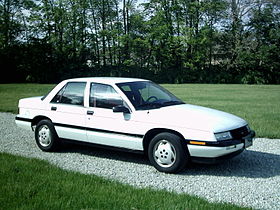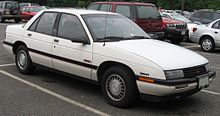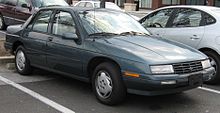Chevrolet Corsica
| Chevrolet Corsica | |
|---|---|
 | |
| Overview | |
| Manufacturer | General Motors |
| Also called | Pontiac Tempest (Canada, 1987-1991) |
| Production | 1987–June 1996 |
| Model years | 1987–1996 |
| Assembly |
Wilmington, Delaware, United States Linden, New Jersey, United States |
| Body and chassis | |
| Class | Compact car |
| Body style |
4-door sedan 5-door hatchback |
| Layout | Transverse front-engine, front-wheel drive |
| Platform | L-body |
| Related |
Pontiac Tempest Chevrolet Beretta Chevrolet Cavalier Pontiac Sunbird Pontiac Grand Am Oldsmobile Achieva Buick Skylark |
| Powertrain | |
| Engine |
2.0 L LL8 I4 (gasoline) 2.2 L LM3 I4 (gasoline) 2.2 L LN2 I4 (gasoline) 2.8 L LB6 V6 (gasoline) 3.1 L LH0 V6 (gasoline) 3.1L L82 V6 (gasoline) |
| Transmission |
3-speed 3T40 automatic 4-speed 4T40-E automatic 4-speed 4T60-E automatic 5-speed manual |
| Dimensions | |
| Wheelbase | 103.4 in (2,626 mm) |
| Length |
183.4 in (4,658 mm) (1987–93) 183.5 in (4,661 mm) (1994–96) |
| Width |
68.2 in (1,732 mm) (1987–93) 68.5 in (1,740 mm) (1994–96) |
| Height |
53.8 in (1,367 mm) (1987–93) 54.2 in (1,377 mm) (1994–96) |
| Chronology | |
| Predecessor | Chevrolet Citation |
| Successor | Chevrolet Malibu |
The Chevrolet Corsica (named after Corsica, France) is a front-wheel drive compact car that was produced by Chevrolet from 1987 to 1996. The Corsica was built upon the L-body platform. It shared the L-body with the 2-door Beretta, and the rebadged revival of the Pontiac Tempest which was essentially the same car, but was only sold in Canada. The Corsica came in two styles and four trims. Sold initially only as a 4-door sedan, it was also available as a 5-door hatchback from model years 1989 to 1991 (replacing the Chevrolet Cavalier hatchback, which was sold only as a 3-door). Corsicas were built alongside the Beretta by both the Wilmington Assembly in Delaware and Linden Assembly in New Jersey.
Contents
Year-to-year changes[edit]
1987–1989[edit]
The Corsica was first sold as a fleet car to rental agencies and large companies in 1987, prior to mainstream release. The Corsica and Beretta were the second best-selling cars in America in 1988, right behind the Chevrolet Celebrity.[citation needed] Many Corsicas were also sold abroad, a few were sold in Europe, in the Netherlands for instance.[citation needed] Much of the suspension components were borrowed from the J-body Chevrolet Cavalier, and the chassis was an extension of that of the J-body, but modeled with similar proportions to the N-body. The L-body platform however, was engineered by Chevrolet rather than Oldsmobile. The car was equipped with either the 2.0 L TBI OHV I4 from the Cavalier, or the 2.8 L MPFI OHV V6 from the Chevrolet Celebrity. The base Corsica's door handles were colored silver, while the Corsica LT/LTZ had black-colored handles. Some earlier models had a column shifter with a handbrake between the front seats, an uncommon configuration for most compact cars of the time. A 5-door hatchback model was introduced for 1989, as was an LTZ performance package that included many suspension parts from the Beretta. A rare XT trim included all the performance parts from the LTZ trim as well as a leather interior, special body kit and spoiler package designed for GM by a third party supplier.
1990[edit]
The base model Corsica was dropped, leaving the LT and LTZ. Both engines offered were increased in displacement. The Corsica now either used the same 2.2 L four-cylinder engine and 3-speed automatic transmission as the Cavalier, or the 3.1 L V6 and 3-speed automatic from the Lumina. Minor changes were made to the interior, mostly around the driver controls.
1991[edit]
For 1991 the Corsica received an extensively updated interior with a standard driver's side airbag and cup holders. Front seatbelts were moved from the doors to the B-pillars. The taillights also received a redesign, from smooth to ridged. This would also be the last year for the 5-door hatchback.
1992[edit]
The only trim level was the LT. The manual transmission was dropped for the V6; it remained available for the four-cylinder engine, although it was only available through special order (few of which ever took place[citation needed]). The 2.2 L OHV engine was now upgraded with sequential fuel-injection (SFI) in the Corsica, unlike the version in the Cavalier which used multi-point fuel injection (MPFI).
1993[edit]
On automatic transmission vehicles, a shift interlock, which required the brake pedal to be applied before the transmission could be taken out of the park position, as well as a low oil level light was added. The 3.1 L V6 equipped cars also lost the "3.1L Multi-Port V6" fender badge.
1994[edit]
The LT model took the place of the base model once again. The 2.2 L engine's power output was increased to 120 hp. The 3.1 L V6 was replaced with the updated Gen III "3100-series" engine (Option code L82) with an output of 160 hp along with an OBD-1.5 System. This new OBD system was not compatible with either OBD-I or OBD-II but included some features from both systems.[clarification needed]
The air conditioning System was now upgraded to use R134 refrigerant, as opposed to environmentally-harmful Freon.
The 3-speed automatic transmission on V6 models was replaced with a 4-speed electronically-controlled automatic transmission with overdrive, and lubricated with 100,000 mile long-life fluid. The 2.2 L engine retained the same 3-speed automatic, but the 4-speed automatic could be special ordered. The front seat belts were moved from the B-pillars to the doors. The manual transmission was also dropped for all US Corsicas this model year, due to lack of consumer demand, although many export models and the Beretta still retained this option.
1995[edit]
The Corsica became the first American car to be equipped with daytime running lights as a standard feature. A new Corsica logo was introduced along with other minor cosmetic exterior changes, such as the introduction of body-colored mirrors, side moldings, and grille. The car also received a revised rear suspension, similar to that of the then-newly redesigned Cavalier. This slightly reduced the "floatiness" of the ride which occurred with earlier models. All Corsicas now came with Dex-Cool engine coolant. The car also received a new tire size, 195/70R14 for longer tire life and better handling.
1996[edit]
The Corsica was converted fully to OBD-II. GM discontinued the Corsica and the Chevrolet Beretta after the 1996 model year, due to safety standards in 1997 that would have required a total re-design of these cars, and competition from the re-designed similarly sized 1995 Chevrolet Cavalier for compact car sales. The Corsica was replaced by the larger Chevrolet Malibu for the 1997 model year.
Production ended on June 26, 1996.[citation needed]
Engines[edit]
- 1987–1989 2.8 L (173 in³) LB6 V6
- 1987–1989 2.0 L (122 in³) OHV I4
- 1990–1996 2.2 L (134 in³) OHV I4
- 1990–1993 3.1 L (189 in³) Gen II V6
- 1994–1996 3.1 L (191 in³) Gen III V6
Notes:
- Both the 2.8 L V6 and 2.0 L I4 received a longer stroke crankshaft in the 1990 model year, respectively increasing their displacements to 3.1 L and 2.2 L.
- In the 1992 model year, sequential fuel injection replaced throttle-body injection on the I4 and in 1994 it replaced MPFI on the V6 models. The updated OBD system is sometimes referred to as OBD 1.5.
External links[edit]
| Wikimedia Commons has media related to Chevrolet Corsica. |
- Consumer Guide: 1990-1996 Chevrolet Corsica Consumer Guide Used Car review of the Chevrolet Corsica
- Chevrolet Corsica article at Wikicars.org
- Chevrolet Corsica / Beretta Europe
| show « previous — Chevrolet, a marque of General Motors, road car timeline, United States market, 1980s–present
|
|---|





